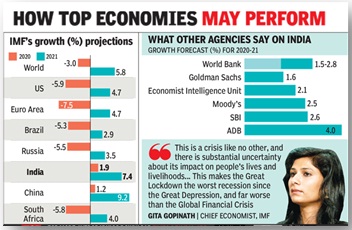

|
Syllabus: Prelims GS Paper I : Current Events of National and International Importance; Economic and Social Development-Sustainable Development, Poverty, Inclusion, Demographics, Social Sector Initiatives, etc. Mains GS Paper III : Indian Economy and issues relating to Planning, Mobilization of Resources, Growth, Development and Employment; Infrastructure: Energy, Ports, Roads, Airports, Railways etc. |
Context
Infrastructure to drive economic growth in post Covid-19 India.
The covid-19 epidemic is the first and foremost human disaster in 2020. Indian economy has shown a steep downward trend. In April to June 2020 quarter the GDP shrank by 24 percent. Some sectors even collapsed completely. In this time there is a single key to revive the economy again which is the Infrastructure.
Picture of Indian Economy in Post Lockdown Days
India is a developing economy, it is stated as an economy passing through demand depression and high unemployment, the lockdown days have slowdown the supply-side, accelerating the slowdown further and jeopardizing the economic wellbeing of millions.
With an increasing number of coronavirus cases, the government had locked down transport services, closed all public and private offices, factories and restricted mobilization. Based on recent studies, some economists have said that there is a job loss of 40 million people (MRD report) in the country, mostly in the unorganized sectors which directly affected the economy in all directions.
In this scenario, they are predicting that India would go into recession affecting the unorganized sector and semi-skilled jobholders losing their employment. The labour sector under the MGNREGA, is worst impacted as they are not provided jobs due to lockdown, most of the labour sectors are associated with the construction companies and daily wage earners. Travel restrictions and quarantines affecting hundreds of millions of people have left Indian factories short of labour and parts, just-in-time supply chains and triggering sales warnings across technology, automotive, consumer goods, pharmaceutical and other industries.
 The quarterly GDP growth has consistently fallen since Q4 of FY18. If there is a deviation in Q4 of FY19, it is because the National Statistical Office (NSO) revised its data on February 28, 2020, drastically cutting down growth rates in the first three-quarters of FY19 (from 8% to 7.1% for Quater1, from 7% to 6.2% in Quarter 2 and 6.6% to 5.6% in Quarter 3.
The quarterly GDP growth has consistently fallen since Q4 of FY18. If there is a deviation in Q4 of FY19, it is because the National Statistical Office (NSO) revised its data on February 28, 2020, drastically cutting down growth rates in the first three-quarters of FY19 (from 8% to 7.1% for Quater1, from 7% to 6.2% in Quarter 2 and 6.6% to 5.6% in Quarter 3.
Infrastructure is Going to Play a Key Role in Reviving Growth
From transportation, logistics, agriculture, industry, tele-communications, finance, healthcare, manufacturing, and education, all sectors rely on a strong infrastructure set up. The infrastructure investments will help boost employment, generate income, in the long run, it is set to boost the growth of the ancillary sectors, allowing stronger revival. Some key infrastructure developments that will drive growth across sectors include:
Conclusion
As an economy, the government initiative to infuse investments in infrastructure is going to play a key role in reviving growth. While the post-COVID-19 economy might look uncertain at first glance, Infrastructure investments have proven precedence for a revival of the economy in the face of an impending global slowdown. While the country is already on the path to resume functions after a long lockdown, the steps for revival are trusted and effective.
Connecting the Article
Question for Prelims
Which of the following most correctly explains the need for infrastructure development for the revival of economy ?
(a) It provides liquidity supply in the economy.
(b) It provides base to the economy.
(c) It provides ethical conduct in the economy.
(d) None of the above
Question for Mains
Infrastructure development is the key for economic growth. Explain.

Our support team will be happy to assist you!
